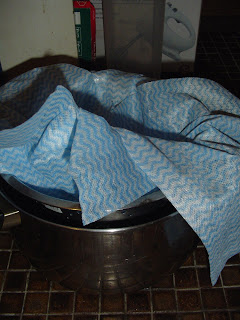When I saw this simple recipe for making ricotta on a blog that I follow (and forgive me because I can't even remember which one) I knew I had no more excuses. It looked too easy to stuff up.
1. Get milk. put it in a clean pot and heat. As soon as it starts to froth (but before it boils) cut off the heat if using gas, or take off the heat if electric.
2. Add one tablespoon of acid (either lemon juice or vinegar) per one litre of milk. Stir.
 Within seconds this was what I saw in the pot. The curds (clumps of cheese) and whey (liquid) had separated and it looked a bit like off milk. funny that.
Within seconds this was what I saw in the pot. The curds (clumps of cheese) and whey (liquid) had separated and it looked a bit like off milk. funny that.3. Get a strainer and line with cheesecloth, or if you're doing this after a meeting at 10pm at night and only the supermarket is open - a couple of chux type cloths.
4. use a pot or bowl to collect the liquid that pours off. It's still very good for you. I used some that night to make up some bread and froze the rest for another batch in place of water.
 5. Tie up the cloth around a wooden spoon so the mixture drains. Allegedly the more whey that is drained off, the longer it will last.
5. Tie up the cloth around a wooden spoon so the mixture drains. Allegedly the more whey that is drained off, the longer it will last. And this is the end result - Ricotta Cheese! I did it, and it was delicious. I put it in the yummy ricotta pancakes from Stephanie Alexander's kitchen garden book. Went down a treat.
And this is the end result - Ricotta Cheese! I did it, and it was delicious. I put it in the yummy ricotta pancakes from Stephanie Alexander's kitchen garden book. Went down a treat.If you've got some milk that's nearing the use by date. You know what to do!

3 comments:
WOW!!!I am impressed.......I think even I could have a go at that!!!
yeah. Although I tried with organic milk last night and it didn't work so well. The first time was with the noname brand. Not sure the difference. It turned out more like cottage cheese than ricotta. Oh well. I have cottage cheese!
Paneer... that's what we call it in India. Its widely used in our local cuisines, especially punjabi and Mughlai cuisine (each Indian state has a different cuisine. Sometimes even 2 or 3)
Post a Comment